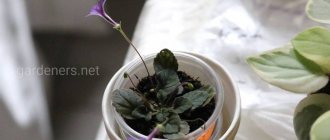When creating home collections of violets, flower growers at a certain stage come to the need to supplement their collection with trailer varieties .
Such varieties, distinguished by their spectacular rosette contours and multiplicity of flowering, are able to add a fresh flavor to any varietal selection and delight with their flowering for quite a long time. Caring for trailer forms will not add problems to collectors, since it differs only in the need to form the outlines of plants.
Main features of cultivation
Differing in the shape of the bush and long flowering, trailers of Saintpaulia have slightly different requirements for the processes of their formation and maintenance than ordinary violets. Some care methods differ in minor nuances.
But there are also specific features - planting methods and bush formation , which is mandatory for many varieties of trailer violets.
Planting methods
You can plant the only child of the plant in the center of the flowerpot , pinch off the growing point, and then form a violet trailer with the required number of flower centers, removing excess stepsons and leaves. This planting is good for plant varieties that produce abundant shoots .
It is advisable to plant varieties of the bush group in one flowerpot, several at a time, preferably in a circle near the edges. And be sure to control the initial size of the children - it must match. The plant's children will give rise to stepchildren and form a smooth clearing.
When planting a leaf with children, a ready-made trailer violet bush will gradually form in the center of the flowerpot.
Features of growth and development
The main distinguishing feature of the processes of contour formation and growth of the trailer violet is its ability to form numerous shoots in the leaf axils, as well as grow elongated stems.
A large number of axillary children, mercilessly removed from ordinary varieties of violets, allows the trailer forms to create their own unique contour of the bush group. Each child has its own growth point, which means it produces strong, slightly elongated stems that grow straight upward. All stems together provide a convex volume.
Stepchildren are not removed from trailers.
The formation of violet trailers of the ampelous group occurs according to a slightly different scenario. They are able to form cascading plant contours due to the growth of elongated stems with axillary children. In this group, the shoots fall down in the form of lashes or are distributed over the surface of the substrate.
The more additional shoots are formed, the more abundant and longer the flowering will be.
Basic care
Comfortable growth of trailer violets requires careful adherence to all basic regimes for keeping plants indoors:
- providing long-term diffuse spectrum lighting and backlighting in winter;
- maintaining the temperature at +20 + 24°C with minor daily differences;
- protection of violet trailers from drafts and sudden temperature fluctuations;
- maintaining proper and regular watering of the plant, avoiding overwatering or drying out of the soil;
- applying fertilizers for adult trailer violets at a time determined by visual monitoring of the plant;
- replanting the plant using the transshipment method as the trailer violet grows out of the pot.
Formation of a flower bush
Many varieties of trailer violets require the formation of a bush outline, otherwise they can grow into a shaggy and awkward plant. There are several ways to create a beautiful specimen , and each gardener chooses the one that suits him:
- You can get the right trailer violet bush from a single child with about 10 leaves . The growth point of such a plant is pinched, due to this the axillary shoots begin to grow. After they are sufficiently decorated, the lower leaves of the plant are removed, and at the same time, damaged or non-standard leaf plates are cleaned. For a beautiful volume of the trailer violet bush, only a few of all the axillary children are left (ideally 5);
Children of the trailer violet.
- when planting several plant children in a circle in one pot, they eventually form a clearing, which requires formation by removing excess leaves and directing shoots to empty spaces;
- It is ideal to form ampelous varieties of trailer violets in a flowerpot on a high leg or in a hanging pot . In this case, part of the plant’s stems are directed downwards, and the remaining stems growing next to them are pinched to create volume in the flowerpot itself;
- Another way of forming ampelous varieties of trailer violets involves laying out the stems of the plant on the substrate - gradually, with the help of new children, an even carpet will be obtained.
ATTENTION! For all methods of forming the outline of a violet trailer, it is necessary to thin out the leaves, control the uniform elongation of the main stems of the plant, and fill the bare areas with newly formed shoots. When these rules are followed, trailer violets turn out to be even, symmetrical plants with evenly filled space with leaf blades and buds.
Violet trailers
What does it mean?
Trailer violets have achieved a special status and become increasingly widespread among flower growers and decorators and landscapers thanks to the peculiarities of their structure.
Let's figure out what a trailer is and how it differs from an ordinary varietal violet?
Trailers are capable of producing a large number of axillary children attached to the mother plant with very shortened stems, which leads to the formation of a voluminous bush.
Or they can slightly lengthen all existing stems , resulting in a cascading plant shape.
IMPORTANT! The presence of whip-like stems and, mainly, the large number of children determine the formation of a large number of buds and the flowering of trailer Saintpaulias for a significant duration.
How to identify them?
To learn to distinguish the trailer violet from the standard forms of this plant, you need some experience in growing Saintpaulias and an understanding of the main distinguishing features of trailers. They are characterized by:
- a large, even volume of the rosette due to the development of children in each leaf axil;
- increased length of all main stems, giving the specimen a cascading outline;
- simultaneous formation of many flowers;
- almost year-round flowering.
Trailer violets (photo of Senk's Azalea Trail variety).
Classification
The division of trailer violets into classification groups is carried out in two directions. Like the standard forms, all Saintpaulia trailers can be distinguished by size, not of the rosette, but of the leaf.
This clarification occurs due to the impossibility of accurately determining the diameter of the rosette due to the presence of a large number of growth points. There is also a specific classification feature that is suitable only for trailer varieties - according to the method of bush formation.
According to the size of the leaf blade
The method helps to identify four groups of trailer violets:
- standard - implies a sheet size in the range of 3.8 - 5 cm and larger. Among the domestic varieties, these include: “Moscow River”;
- "Amur river";
- "River Irtysh".
Irtysh River.
- "White pearls";
LE-Curly hops.
- "Senk's Azalea Trail";
LE-Pearl.
- "N-Gossip Girl";
Teeny Bopper.
By nature of growth
Depending on the contour of the bush formed during the development process, trailer violets are divided into two groups:
- ampelous - form cascade forms of a bush due to freely hanging whip-like stems or voluminous serpentine contours due to the stems being secured with pins in the form of a pattern on the surface of the substrate. The length of the shoots can exceed 0.5 m. Ampelous varieties belong mainly to foreign selection, but recently domestic masterpieces have also begun to be registered: “Rechka-Severka”;
- «2000»;
- "Volga river".
River-Severka.
- "Chanta-Mara";
Photo catalog of common varieties
Of the variety of varieties of trailer violets, some are especially popular. Below we will present photos and names of the most common trailers used in home growing.
Edee s Rosebud – “Rose Bud”
A miniature trailer with a pronounced but sometimes disappearing variegation : the leaf plates are painted in a light green color with a golden tint.
Forms numerous buds of a pastel, peach hue, opening with terry corollas with dense filling. The contour forms independently and is characterized by rapid growth.
Edee's Rosebud.
The variety belongs to the hanging method of cultivation . Can grow to a semi-miniature group.
Lituanica
An old selection variety that was not previously considered a trailer violet . But for its ability to actively form axillary children, it is currently included in the semi-miniature group of trailers.
It has leaf blades with pointed edges, painted dark green. It blooms for a long time with a large number of pink corollas with iridescent colors, but on the condition that all stepsons are removed from the plant. The flowers are double, full, and resemble dahlias.
Lituanica.
Violet belongs to the bush growing method . The variety does not like interference from gardeners.
Rob's Vanilla
Semi-miniature trailer , in some cases not wanting to form axillary children in sufficient quantities. Not always ready to form a compact bush from it, likes to form an outline on its own.
Provided that the flower shoots are pinched and cut off in the early stages of growth, the plant can develop into a harmonious bush with a strong stem and not too elongated stems.
The variety produces a mass of double roses in white, pinkish and cream shades.
Rob's Vanilla.
Trailer for the hanging method of growing . Prefers to grow in a group of several specimens in one flowerpot.
Dancin
trailer . It is distinguished by its dark green leaf blades, colored underneath with a reddish tint.
The variety produces slightly double corollas of red-raspberry color.
Dancin.
Trailer violet is a bush growing method. The variety has a significant drawback - it is very slow : it grows for a long time, thoughtfully forms buds and does not bloom many of them.
Rondita
A variety from the semi-miniature trailer group . A distinctive feature of the plant is the almost complete absence of the pinching process . It is best to create a decorative outline by planting several specimens in one flowerpot. The variety is too moisture-loving.
The leaf blades of the trailer violet are round in shape, colored in a deep shade of green. Forms a large number of terry corollas with dense filling. The color of the flowers is pink with a bright tint.
Rondita.
Trailer violet belongs to the hanging method of cultivation . The peculiarity of the variety is that it is not afraid of direct rays of the sun.
Ramblin silver
Semi-miniature trailer , representative of a group of varieties with variegated foliage. The leaf blades are painted in a light green color with yellowish streaks.
The variety produces white, semi-double corollas. Often sports, forming pink flowers.
Ramblin silver.
Trailer violet is a bush growing method.
What it is?
Of the known variety of violets, ampel violets are the most unusual; they are also called trailer Saintpaulias . A special feature of this plant is the large number of rosettes, which entails the appearance of many flowers. The formation of rosettes occurs in the leaf axils; they are elongated stems, which are much shorter in ordinary varieties.
Modern trailers look great. Their growth characteristics allow them to please their owners with their flowers on an ongoing basis. At the same time, the flowers of ampelous violets can be painted in different colors and have a variety of shapes. This variety is also characterized by variegation. Saintpaulia has the shape of a hemisphere, which is equipped with evenly spaced flowers and foliage.
The main difference between ampelous violets is their growth form. Thanks exclusively to her, this plant is used for growing in pots and for creating hanging gardens and flower beds. Trailers means Saintpaulias, which have several growing points and long drooping stems.
Features of care
Saintpaulias of trailer forms, in terms of the conditions for keeping them indoors, are not much different from ordinary varieties of violets: they are not too demanding in the process of care, they only sometimes show their character, they do not like transplants, but they definitely need to form a decorative outline.
You just need to study their life attitudes and follow the advice of experienced flower growers to get decorative bushes.
Content Rules
The main conditions for the comfortable growth of any plant are:
- correct placement of the specimen in the room;
- creating the necessary light regime;
- maintaining temperature indicators at the required level.
In terms of lighting, violet trailers have some requirements. Due to the constant formation of buds, they need long daylight hours (ideally half the day) without prolonged exposure to direct rays of the sun.
These conditions can be met by placing the pots on the windowsills on the east or west side and creating additional lighting with fluorescent spectrum lamps in cold seasons.
Flowering for a long time in trailer forms of violets is impossible without slight differences in temperature at different times of the day and night.
The optimal temperature characteristics for them will be +20 + 24°C during the day and about two degrees less at night. It should be noted that the age of the trailer violet affects its temperature preferences: young specimens are more demanding of heat than adult plants.
CAREFULLY! All varieties of trailer Saintpaulias cultivated at home are especially afraid of drafts and sudden temperature changes. Therefore, ventilation of premises should be carried out under close monitoring of air flow movements in dangerous proximity to violets. And under no circumstances should they be allowed to be exposed to direct blows.
Watering requirements
Compliance with the irrigation regime involves regular watering without overflowing or drying out the soil at any time of the year. The amount and frequency of watering depends on the room temperature, air dryness, the size of the flowerpot and the trailer plant itself. It is optimal to water once every 7 days , but for mini and microminiature groups - a little more often due to their small size.
Microminiature varieties are watered more often than standard varieties.
For a trailer violet, it is necessary to create a good drainage system in the vessel. also drain excess water from the pan to prevent rotting of the roots.
Top dressing
Trailer varieties of violets are in a blooming state for most of the year, so for sufficient nutrition they need regular, but not frequent feeding.
Fertilizers should be applied once a month after preliminary watering of the plant . The dose indicated on the package should be reduced several times. It is possible to alternate feeding with organic and mineral fertilizers.
It is forbidden to feed recently planted or transplanted specimens (the standby period is about 2 months) - there is a danger of chemical burns to the plant from an overdose of fertilizer.
It is not recommended to feed young plants until they are two years old.
Transfer
fast-growing young specimens twice a year , provided they grow out of an old flowerpot. With each subsequent transplant, the pot is taken to be slightly larger in diameter, but its depth does not need to be increased.
As the violet-trailer grows up, it begins to have an increasingly negative attitude towards interference in its life rhythms. Therefore, transplants are reduced to once every 3 years , carried out using the transshipment method. Gradually you can move on to partial replacement of the top layer of the substrate.
Adult trailer violets do not like frequent transplants.
ADVICE! To enhance the decorative effect that trailers of hanging violets have, you should choose flowerpots with high stems or hanging vessels. This will make it more convenient for the plant to form its contour.
After transshipment and slight compaction of the substrate, you need to remove old, damaged and non-standard leaves to allow the trailer violet to quickly grow more children and form a lush green mass.
Diseases and pests
The most common pests of violets are:
- Ticks. The plant can be attacked by different types of mites. For example, red spider mites leave red dots on the leaves around which cobwebs can be observed. Because of this, the leaves lose their shape and dry out. Spider mites leave depressed brown spots in older outer leaves. The cyclamen mite is characterized by round and yellow spots;
- Gray rot is a grayish-brown coating. Appears on leaves, petioles and flowers;
- Aphids form from recently cut flowers. Green insects spoil flowers, buds, and flower stalks. They drink violet juice.
Reproduction
Trailer violets are capable of forming young specimens in two ways:
- rooting the selected shoot without separating it from the mother plant;
- the formation of children on the rooted leaf plate.
The main condition for the rapid formation of roots and painless separation of overgrown cuttings is the use of a special substrate.
It can be prepared from ordinary soil with the addition of a significant amount of loosening agent (perlite), but you can also replace the soil with sphagnum.
Provided additional illumination, the root system in children or cuttings is formed quite quickly (about 15 days). After planting new specimens in their own flowerpots, they should set up a kind of greenhouse for several days. Further care is carried out according to the standard scheme.
Landing
In order to grow an ampelous violet, you should give preference to a low and wide container. It should be planted exclusively in a substrate that contains a lot of baking powder. The need for replanting can be determined by the age and size of the plant. Often, without damaging the flower, this can be done twice a year .
Plants that look like a small clearing can be replanted once every 2-3 years. The reason for this is the difficult seating procedure. You can use the method of pouring fresh fed substrate directly into the pot. In this way, the soil is renewed without harming the flower, as well as filled with minerals that have already been removed from the soil. The soil for violets should be light, breathable, and have a peat or perlite base.
Violets do not prefer deep pots - their root system is mainly located on the surface. Since the hanging variety produces vines that subsequently hang down, it is better to plant the trailer in a hanging pot or install it on a stand.











